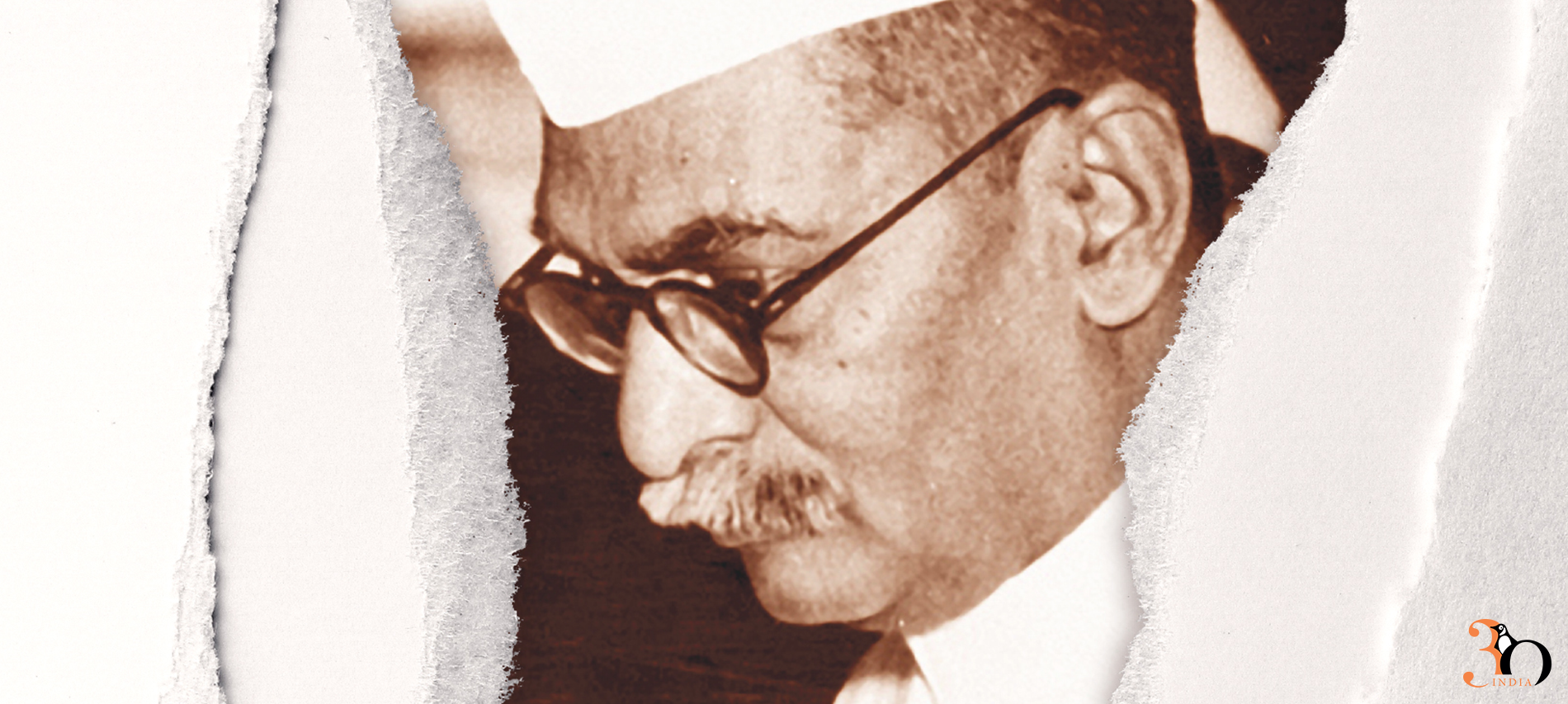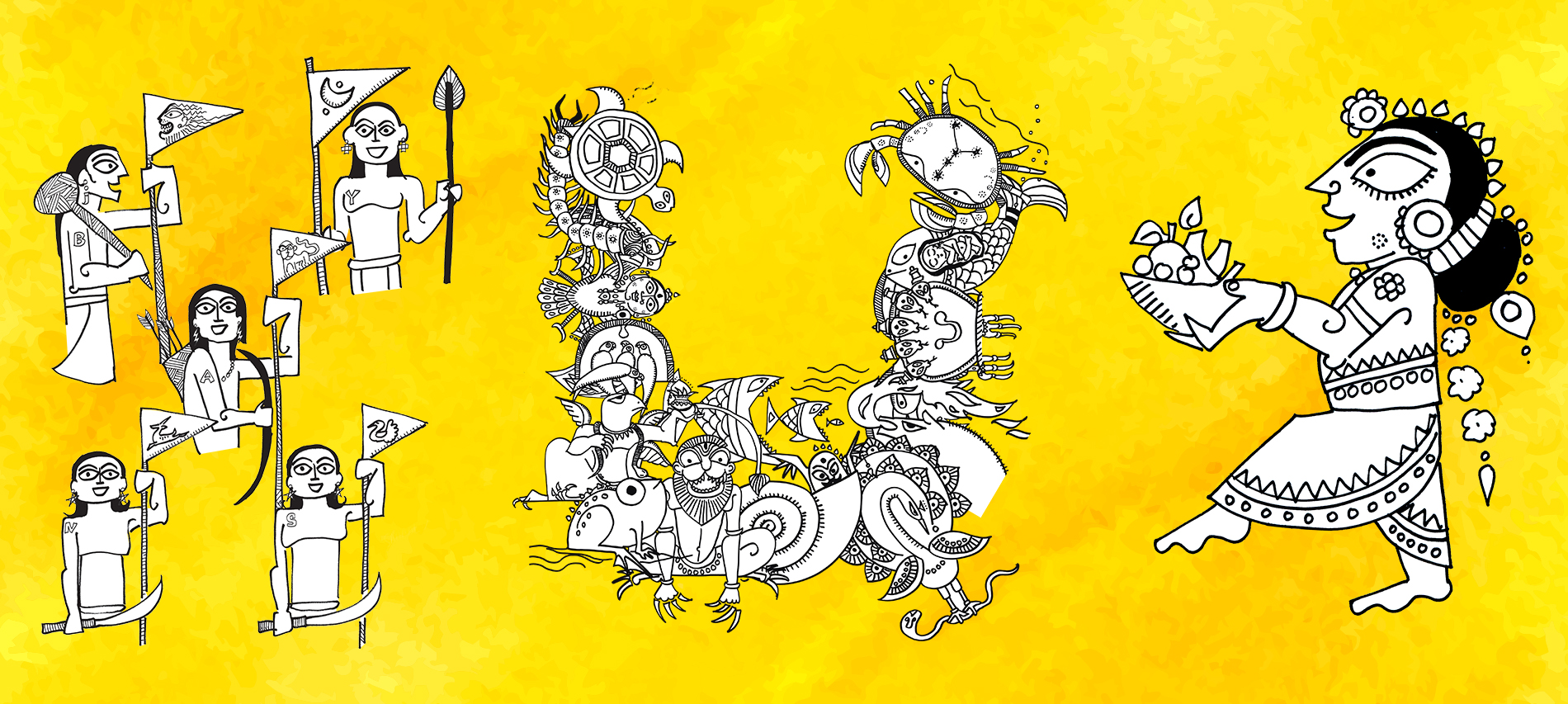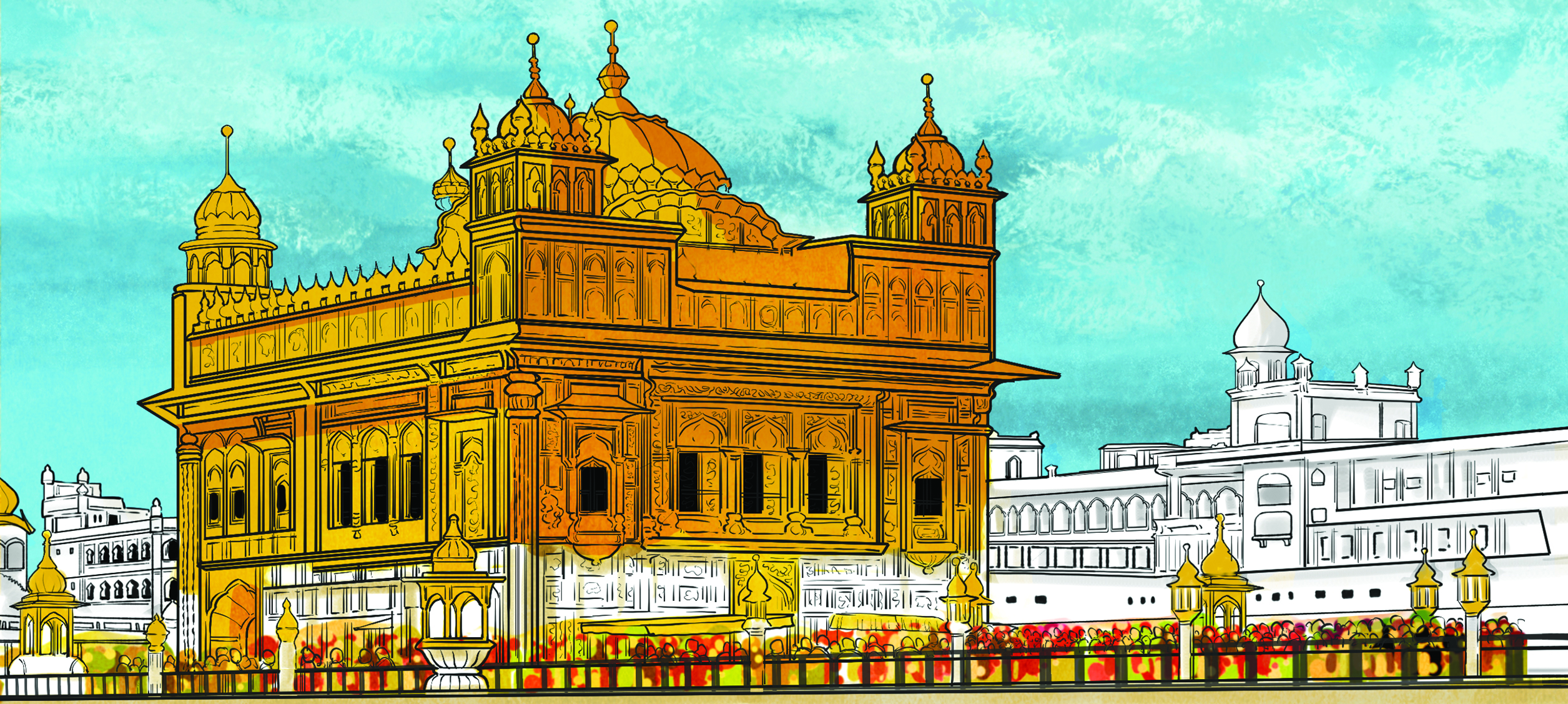When an army of five fights against a battalion of a hundred, what happens? Devdutt Pattanaik’s ‘The Boys Who Fought’ looks at the Mahabharata not as an epic war for revenge, but one for the cause of dharma.
Here’s an excerpt from Pattanaik’s Mahabharata with a twist.
Once upon a time, there was a man called Vyasa. His father was a sage. His mother was a fisherwoman. He was born on a river island, and had a dark complexion.
Vyasa grew up watching animals fight. Then he saw humans fight. And he wondered, what was the difference?
In the forest, the mighty eat the meek. In human society, the mighty can take care of the meek. This is dharma, realized Vyasa. It creates a decent human society.
Inspired, Vyasa wrote an incredible story in 1,00,000 verses, split into eighteen chapters, about the fight between a hundred brothers and their five cousins.
Ganesha, who has the head of an elephant, wrote down Vyasa’s story, which became renowned as the Mahabharata, the great Indian epic, for Bharata is another name for India.
Others called it Bharata Kavya, the song of the Bharatas, for the hundred brothers and their five cousins belonged to the Bharata clan, also known as the Kuru clan, which once ruled over India.

Some people called the story Vijaya, the story of victory, for it describes how the Pandava five, with just seven armies, defeated the Kaurava hundred, with eleven armies, in an eighteen-day-long war.
Vyasa, however, insisted that his epic should be called Jaya, a victory in which no one was defeated. For, in the story, Krishna of the Yadu clan, cousin to both the Pandavas and the Kauravas, reveals a different kind of fight—a greater fight that takes place before weapons are raised on the battlefield, a fight of thoughts and emotions that arises inside our minds and hearts.

Can’t wait to read more? ‘The Boys Who Fought’ is coming soon!

Tag: Penguin Random House
What Do We Learn from Roald Dahl’s Books?
Roald Dahl’s books7 have made our childhoods magical. As their characters stepped into bizarre worlds, met strange people and accomplished something fantastic by the end, we were often left with a warm, happy feeling from within.
But the brilliant Roald Dahl made sure he never missed out on leaving small messages for his young readers, in the disguise of magical words woven into fascinating tales.
Here are a few things we have learned from Roald Dahl’s books.
When he showed us why it’s important to be a good person.

When he showed us why it’s important to be extraordinary.

When he taught us the secret to never growing old!

When he showed us how there’s no end to knowledge.

Share with us what you learned from your favourite Roald Dahl book this Roald Dahl Day!
Everything You Need to Know About Level 5 Leadership
IN 1971, A SEEMINGLY ordinary man named Darwin E. Smith was named chief executive of Kimberly-Clark, a stodgy old paper company whose stock had fallen 36% behind the general market during the previous 20 years. Smith, the company’s mild-mannered in-house lawyer, wasn’t so sure the board had made the right choice—a feeling that was reinforced when a Kimberly-Clark director pulled him aside and reminded him that he lacked some of the qualifications for the position. But CEO he was, and CEO he remained for 20 years.
What a 20 years it was. In that period, Smith created a stunning transformation at Kimberly-Clark, turning it into the leading consumer paper products company in the world. Under his stewardship, the company beat its rivals Scott Paper and Procter & Gamble. And in doing so, Kimberly-Clark generated cumulative stock returns that were 4.1 times greater than those of the general market, outperforming venerable companies such as Hewlett-Packard, 3M, CocaCola, and General Electric.
Smith’s turnaround of Kimberly-Clark is one the best examples in the twentieth century of a leader taking a company from merely good to truly great. And yet few people—even ardent students of business history—have heard of Darwin Smith. He probably would have liked it that way. Smith is a classic example of a Level 5 leader—an individual who blends extreme personal humility with intense professional will. According to our five-year research study, executives who possess this paradoxical combination of traits are catalysts for the statistically rare event of transforming a good company into a great one. (The research is described in the sidebar “One Question, Five Years, 11 Companies.”)
“Level 5” refers to the highest level in a hierarchy of executive capabilities that we identified during our research. Leaders at the other four levels in the hierarchy can produce high degrees of success but not enough to elevate companies from mediocrity to sustained excellence. (For more details about this concept, see the exhibit “The Level 5 Hierarchy.”) And while Level 5 leadership is not the only requirement for transforming a good company into a great one— other factors include getting the right people on the bus (and the wrong people off the bus) and creating a culture of discipline—our research shows it to be essential. Good-to-great transformations don’t happen without Level 5 leaders at the helm. They just don’t.
Not What You Would Expect
Our discovery of Level 5 leadership is counterintuitive. Indeed, it is countercultural. People generally assume that transforming companies from good to great requires larger-than-life leaders—big personalities like Lee Iacocca, Al Dunlap, Jack Welch, and Stanley Gault, who make headlines and become celebrities.
Compared with those CEOs, Darwin Smith seems to have come from Mars. Shy, unpretentious, even awkward, Smith shunned attention. When a journalist asked him to describe his management style, Smith just stared back at the scribe from the other side of his thick black-rimmed glasses. He was dressed unfashionably, like a farm boy wearing his first J.C. Penney suit. Finally, after a long and uncomfortable silence, he said, “Eccentric.” Needless to say, the Wall Street Journal did not publish a splashy feature on Darwin Smith.
But if you were to consider Smith soft or meek, you would be terribly mistaken. His lack of pretense was coupled with a fierce, even stoic, resolve toward life. Smith grew up on an Indiana farm and put himself through night school at Indiana University by working the day shift at International Harvester. One day, he lost a finger on the job. The story goes that he went to class that evening and returned to work the very next day. Eventually, this poor but determined Indiana farm boy earned admission to Harvard Law School.
He showed the same iron will when he was at the helm of Kimberly-Clark. Indeed, two months after Smith became CEO, doctors diagnosed him with nose and throat cancer and told him he had less than a year to live. He duly informed the board of his illness but said he had no plans to die anytime soon. Smith held to his demanding work schedule while commuting weekly from Wisconsin to Houston for radiation therapy. He lived 25 more years, 20 of them as CEO. Smith’s ferocious resolve was crucial to the rebuilding of Kimberly-Clark, especially when he made the most dramatic decision in the company’s history: selling the mills.
This is an excerpt from HBR’s 10 Must Reads (On Leadership). Get your copy here.
Credit: Abhishek Singh
9 Indian Classics That You Must Read (If You Haven’t Already)
From the endless number of books written by Indian writers in multiple languages, there have been a few which have broken barriers of time and language successfully. Read by millions of people down in India and across the world, here are nine classics that you should include in your ‘must-read’ list, if you haven’t already.
Abhijnanashakuntalam

Arthashastra

Baburnama

Home and the World

I, Lalla

Kamasutra

Kural

My Name is Radha

Tamas

Grab your set of these timeless stories here today!

7 Lessons of Communal Harmony from India’s first President that are the Need of the Hour
Written by Dr. Rajendra Prasad, India Divided is a first-hand testimony of what went on behind the Partition that forever changed the lives of the people in the Indian subcontinent.
Dr. Prasad’s book not only traces the origins of the Hindu-Muslim conflict but also explores how Partition was an unviable solution to a question that has remained unresolved till today.
Here are seven instances from India Divided which show us why it’s important to seek peace, love and mutual respect on either side of the line
When one must not forget to remember that a society does not thrive in isolation and that history does not begin with loss.

When the stakeholders must remember that a solution does not seek lives, but is in the interest of one and all.

When one must not forget that ‘homogenous’ people is perhaps not an answer to the question.

When one must realise that oppression, in any form, can never help a society progress.

When one must emphasise on the importance of an inclusive society.

When one should hark back to the times of complete peace and harmony, a state that is perhaps not unachievable.

And when one must not forget that years ago, the natural state of cohabiting for Hindus and Muslims, was not in neighbouring nations.

Dr. Rajendra Prasad’s words help us find our bridge over troubled waters even years after he wrote them. Grab your copy of India Divided here today!
7 Quotes by Novoneel That Will Leave a Chill Down Your Spine
Novoneel Chakraborty is a master when it comes to romance thrillers. His books A Thing beyond Forever and That Kiss in the Rain have been appreciated by thousands all over the country. They have also appeared in numerous bestsellers’ lists at different points in time since their releases.
Novoneel is back with another beguiling tale of dark romance and thrill, Forever is a Lie.
Here are seven quotes from the book that will send a chill down your spine.







Intrigued? Get your copy of Novoneel Chakraborty’s Forever is a Lie right now!

Have You Introduced Your Child to Devdutt Pattanaik’s Mythological Stories with a Twist?
Hailed as one of India’s favourite mythologists, Devdutt Pattanaik’s books introduce us to the world of Indian mythologies and epics with a fun and interesting twist.
Before you wonder how you’ll take on the difficult task of getting your child to remember the countless stories from our epics, let’s look at the wonderful world of some of Devdutt Pattanaik’s books.
Fun in Devlok Omnibus

Do you know the name of the demon with poor memory? Do you know the story of the time Lord Krishna landed at the airport? Have you heard of the big fight between Kama and Yama? Dive right into the amazing world of Devlok with this beautifully illustrated book!
Pashu

In Indian mythology, a fish rescues the world from destruction and a horse can fly high. But where do these animals come from? Why are some of them looked upon with dread, while the rest are worshipped with the Gods and Goddesses? Devdutt Pattanaik unravels the mysteries of the interesting animal world in Indian mythologies in this delightfully illustrated book!
The Girl Who Chose

The epic of Ramayana has been told and retold through generations from the points of view of Ram and Ravana. But little did we notice that the pivot always was Sita and her five choices. What were they? Find out with Devdutt Pattanaik’s beautiful book with stunning illustrations!
If you’ve plunged right into the fascinating world of Devdutt Pattanaik’s books, here’s one more about the Mahabharata waiting for your collection!

Things You Didn’t Know About ‘Vyasa’ Illustrator Sankha Banerjee
The first in the series that retells the story of the epic Mahabharata, Vyasa sets the stage for the battle of Kurukshetra. This brilliantly illustrated graphic novel is authored by Sibaji Bandopadhyay.
Bringing this epic to life is artist Sankha Banerjee, who enthralls the readers with the many illustrations in the graphic novel.
Here’s taking a sneak peek into the interesting life of Sankha Banerjee.






We bet you’re as dazzled by his art work as we are!

Journey to the Circuit House: ‘The Adventures of Feluda: The Golden Fortress’ — An Excerpt
Satyajit Ray’s much celebrated Bengali detective — Feluda, is now on a mission in the royal sands of Rajasthan!
In ‘The Adventures of Feluda: The Golden Fortress’, the detective dodges impostors, deadly scorpions and bullets to rescue young Mukul, a boy who can recall his past life.
Here’s a peek into Feluda’s spine-chilling chase to the end of the mystery.
The train started. Feluda took out the book on Rajasthan from his shoulder bag. I took out Newman’s Bradshaw timetable and began looking up the stations we would stop at. Each place had a strange name: Galota, Tilonia, Makrera, Vesana, Sendra. Where had these names come from? Feluda had told me once that a lot of local history was always hidden in the name given to a place. But who was going to look for the history behind these names?
The train continued to chug on its way. Suddenly, I could feel someone tugging at my shirt. I turned to find that Lalmohan Babu had gone visibly pale. When he caught my eye, he swallowed and whispered, ‘Blood!’
Blood? What was the man talking about?
Lalmohan Babu’s eyes turned to the Rajasthani. The latter was fast asleep. His head was flung back, his mouth slightly open. My eyes fell on the foot on the bench. The skin around the big toe was badly grazed. It had obviously been bleeding, but now the blood had dried. Then I realized something else. The dark stains on his clothes, which appeared to be mud stains, were, in fact, patches of dried blood.
I looked quickly at Feluda. He was reading his book, quite unconcerned. Lalmohan Babu found his nonchalance too much to bear. He spoke again, in the same choked voice, ‘Mr Mitter, suspicious blood marks on our new co-passenger!’
Feluda looked up, glanced once at the Rajasthani and said, ‘Probably caused by bugs.’
The thought that the blood was simply the result of bites from bed bugs made Lalmohan Babu look like a pricked balloon. Even so, he could not relax. He continued to sit stiffly and frown and cast the Rajasthani sidelong glances from time to time.
The train reached Marwar Junction at half past two. We had lunch in the refreshment room, and spent almost an hour walking about on the platform. When we climbed into another train at half past three to go to Jodhpur, there was no sign of that Rajasthani wearing a red shirt.
Our journey to Jodhpur lasted for two-and-a-half hours. On the way, we saw several groups of camels. Each time that happened, Lalmohan Babu grew most excited. By the time we reached Jodhpur, it was ten past six. Our train was delayed by twenty minutes. If we were still in Calcutta, the sun would have set by now, but as we were in the western part of the country, it was still shining brightly.
We had booked rooms at the Circuit House. Lalmohan Babu said he would stay at the New Bombay Lodge. ‘I’ll join you early tomorrow morning, we can all go together to see the fort,’ he said and went off towards the tongas that were standing in a row.
We found ourselves a taxi and left the station. The Circuit House wasn’t far, we were told. As we drove through the streets, I noticed a huge wall—visible through the gaps between houses—that seemed as high as a two-storeyed house. There was a time, Feluda told me, when the whole of Jodhpur was surrounded by that wall. There were gates in seven different places. If they heard of anyone coming to attack Jodhpur, all seven gates were closed.
Our car went round a bend. Feluda said at once, ‘Look, on your left!’
In the far distance, high above all the buildings in the city, stood a sprawling, sombre-looking fort—the famous fort of Jodhpur. Its rulers had once fought for the Mughals.
I was still wondering how soon I’d get to see the fort at close quarters, when we reached the Circuit House. Our taxi passed through the gate, drove up the driveway, past a garden, and stopped under a portico. We got out, collected our luggage and paid the driver.
A gentleman emerged from the building and asked us if we were from Calcutta, and whether Feluda was called Pradosh Mitter.
‘Yes, that’s right,’ Feluda acknowledged.
‘There is a double room booked in your name on the ground floor,’ the man replied.
We were handed the Visitors’ Book to sign. Only a few lines above our own names, we saw two entries: Dr H.B. Hajra and Master M. Dhar.
The Circuit House was built on a simple plan. There was a large open space as one entered. To its left were the reception and the manager’s room. In front of it was a staircase going up to the first floor, and on both sides, there were wide corridors along which stood rows of rooms. There were wicker chairs in the corridors.
A bearer came and picked up our luggage, and we followed him down the right-hand corridor to find room number 3. A middle-aged man, sporting an impressive moustache, was seated on one of the wicker chairs, chatting with a man in a Rajasthani cap. As we walked past them, the first man said, ‘Are you Bengalis?’ Feluda smiled and said, ‘Yes.’ We were then shown into our room.
We bet you can’t wait to find out what happens next! Grab your copy of ‘The Adventures of Feluda: The Golden Fortress’ today!

Stepping Into the Golden Temple: ‘Amma, Take Me to the Golden Temple’ — An Excerpt
Bhakti Mathur’s ‘Amma, Take Me to the Golden Temple’, is a fascinating guide through the rich history and architecture of the magnificent Darbar Sahib in Amrtisar.
As Amma takes her children, Shiv and Veer, through the corridors of the temple, following the stories of all the Sikh Gurus and getting a taste of the langar from the world’s biggest kitchen, we immediately wish we would be transported to the Golden Temple with them!
Before you get ready for your trip to the Golden Temple with your children, here’s a glimpse of the grandeur you’re about to witness!
It was well before the sun woke up. Amma and the two boys walked barefoot in the darkness across the vast courtyard. Amma cajoled the children with quiet words of encouragement. ‘Just a little bit more, Shiv.’ And a few steps later, ‘We are almost there, Veer.’ The boys, half asleep and too tired to protest, stumbled along, holding on tightly to Amma’s hands. What had seemed like a great idea the evening before—getting up early to meet a 400-year-old guru who lived in a floating temple made of gold—wasn’t looking so grand now!
‘Here we are!’ announced Amma. They had finally reached the magnificent arched gateway that led to the temple complex. The boys got a jolt as they stepped into the shallow pool of cold water meant to cleanse one’s feet before entering the holy grounds beyond. Shiv rubbed his eyes to check that he wasn’t still warm in his bed, dreaming. A Sikh man with a long black beard and wearing a blue tunic stood guard, towering over them, holding a tall spear in one hand.
‘Veer, look!’ Shiv whispered loudly. His brother was doing exactly that, staring at the impressive figure of the guard, as he too rubbed the sleep from his eyes. White teeth peeked from under the guard’s thick moustache as he offered a broad welcoming smile to the boys. They smiled back, relieved at the display of friendliness.
‘Come along now,’ urged Amma, her heart beginning to beat quickly. She gently pushed the boys across the wide threshold of the massive doorway. They stopped. Straight ahead, in the middle of a large lake, brilliantly lit and bright against the background of the dark sky, stood an elegant domed square structure seemingly carved out of solid gold. There it was. The Golden Temple of Amritsar!
Lost for words, the three took in the wondrous sight for a few long moments. A f lock of pigeons flew off their perch atop the shiny dome of the temple and the sound off lapping wings broke their trance. Amma, Shiv and Veer started walking down a f light of steps, taking in their magnificent surroundings. The temple stood in the middle of a square shaped lake, bordered on all four sides by a wide walkway of tiled marble. A narrow causeway connected the temple to the walkway. An array of buildings, shrines and monuments of different shapes and sizes, with minarets and domes rising above them, enclosed the complex.
They stepped on to the walkway and the marble felt soothingly cool under their bare feet. There was a smattering of people around. Some sat quietly by the water’s edge, moved by the soul-stirring calmness of the beauty surrounding them. Some prayed with their foreheads touching the ground or simply with their hands folded. Some were busy at work, sweeping the night’s accumulation of dust and dirt from the black-and-white marble f loor, while others still lay asleep, wrapped in light cotton blankets.
Soothing hymns sounded softly from loudspeakers attached to the walls along the edge of the walkway. Even though Shiv and Veer did not understand the words, the simplicity of the music stirred them. The loud sound of drumbeats came rolling from one part of the temple complex. Fully awake now, Shiv and Veer ran in the direction of the drums and it was now Amma’s turn to try and keep up with them. Where the drumbeats were coming from, a crowd had gathered in front of a multi-storeyed building made of white marble with brightly lit golden domes topping its roof.
‘This is the Akal Takht, the timeless throne,’ Amma told them.
In the middle of the crowd stood a golden palki, a palanquin. Its walls were engraved with intricate designs and it was lined with red velvet on the inside. It was exquisite. As one group of people decorated it with strands of marigold and roses, another group made its way towards it from the Akal Takht. In their midst, a man with a long silver beard stood wearing a brightblue turban, a sword hanging from a cloth belt tied around his waist. On his head he carried, with great reverence, a bundle wrapped in white silk.
‘Is that the guru, Amma?’ Shiv asked, tugging at Amma’s dupatta. ‘Is he really 400 years old?’
Amma smiled mischievously and said, ‘Yes and no. Yes, that is the guru and it is indeed 400 years old. But if you are asking me whether that man is the guru, then no, he is not. That man is carrying the guru.’
‘What!’ Veer exclaimed. ‘What do you mean, he is carrying the guru?’
‘The bundle on his head is the guru. It is a book called the Guru Granth Sahib, a collection of hymns, poems and words of wisdom of the real gurus from their lifetime, and of other wise men from more than 400 years ago. The Sikhs consider this book to be their guru.’
Shiv and Veer looked at Amma as if they had been cheated.
‘Don’t look so disappointed, boys! There is a wonderful story about how this book came to be the guru and I will tell you about it later. Now, let’s not miss out on the ceremony!’
People were craning their necks to look above those in front of them for a glimpse of the precious bundle as it was being carefully placed inside the palki. Then a group of men lifted the palanquin. Others ran towards it, some to take turns at helping to carry it, others just to touch it. People showered rose petals on the bearers and a single chant arose from the crowd: ‘Wahe Guru! Wahe Guru! Wahe Guru!’ A long procession soon formed behind the palki, swallowing Amma, Shiv and Veer as they moved along with it.
Get ready for your child to guide you through the Golden Temple the next time you visit!
Coming soon — ‘Amma, Take Me to Tirupati’.

















